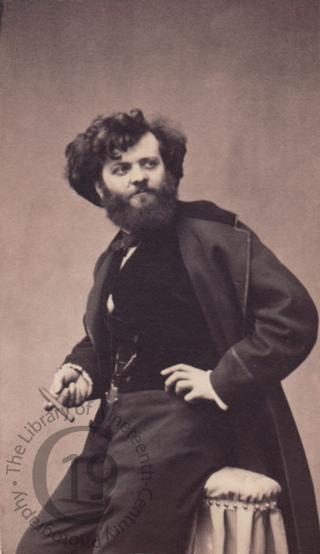
Pierre Petit
Born at Aups in the South of France in 1831, Pierre Petit started his photographic career as a daguerreotypist in 1849, before joining the team of assistants at Disdéri’s studio in 1855. He left Disdéri in 1858, setting up in business with Antoine René Trinquart. The following year the two men established a studio at 31, place Cadet under the name La Photographie des Deux Mondes. The Petit-Trinquard partnership only lasted until 1862, but Petit contined to operate at the same address throughout the rest of the century.
From the earliest days, Petit began a Galerie des hommes de jour, followed swiftly by portraits for an album to be titled l’Episcopat français, clergé de Paris. In 1860 he proposed a series of 1,500 celebrities. Working from wet collodion negatives, Petit produced magnificence portraits of the men of the day. Unlike his contemporaries Nadar and Adam-Salomon, Petit frequently visited the homes of his clients to take their portraits. Experimenting with permanent pigment processes, he acquired from Alphonse Poitevin the right to practise carbon printing. Having already opened a branch in Baden, around 1862 he opened another at Marseilles in partnership with Emile Cazalis. He participated in exhibitions of the SFP in 1859 and 1861, with Trinquart in 1863, and again on his own in 1867.
By 1862 he had established himself as the photographer of choice for the French episcopacy and religious orders. He further consolidated his links with the clergy when he became the proprietor of the journal Les Veillées chrétiennes in 1863. By 1864 he could claim to have 25,000 ecclesiastical portraits in his archive.
When the Exposition Universelle opened at Paris in 1867, Pierre Petit held the monopoly for photography at the exhibition, Léon et Lévy holding the monopoly for stereoscopic photography and Michelez that for reproducing works of art.
In 1871 he photographed the siege and the burning of Paris, and in 1873 he collaborated with Paris-Théâtre, producing portraits of many actors and singers. Between 1871 and 1876 he documented the construction of the Statue of Liberty. One of the first to utilize electric light properly for portraiture, in 1880 he experimented with Liébert on its use, and in 1886 he invented a new process for printing portraits on fabric. Between 1887 and 1889 he recorded the construction of the Eiffel Tower. In 1908 he handed over the business to his son. Pierre Petit died in 1910.
Self-portrait by the photographer.
Code: 124231




